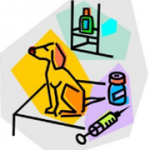What is Blue-Green Algae?
Blue-green algae (Cyanobacteria) are microscopic bacteria found in freshwater lakes, streams and ponds. They can produce toxins that affect people, livestock and pets that swim in and drink from the contaminated water. Blue – green algae will grow to form areas that give the water a blue-green appearance in colour which can appear like a paint or film on top of the water. Algal concentrations vary throughout the year and are most likely to be found in nutrient-rich water. There are many species of blue-green algae; only some produce toxic compounds. These toxins have a high acute toxicity and exposure frequently results in fatality.
How can it impact my pet?
Dogs that enjoy swimming, playing or drinking in lakes and ponds may be exposed to blue-green algae as well as other pets that may have access to the water. DO NOT allow your pet to swim in lakes or ponds that have blue-green algae or signs warning of its potential presence.
What are the clinical signs of my pet being affected?
The clinical picture will be dependent on the type of algae and toxin ingested. The onsets of the effects are usually within one hour and can be within 15 minutes. The blue-algae can cause acute vomiting, abdominal tenderness, hyper-salivation, haematemesis, blue discolouration to the skin, breathing difficulties and tremors. Liver failure may also develop from ingestion.
What do I do if I think my pet has been exposed to the blue-green algae?
Unfortunately, there is no antidote for the toxins produced by blue-green algae. Immediate veterinary care is imperative and your pet must be taken to your registered vets. Unfortunately, with blue-green algae, the prognosis can be very poor, and some dogs actually pass away before being able to get to a veterinarian so its vital you have the number of your local vet in your wallet or phone in case of any emergency.
What is the treatment if my pet has been affected?
Once your pet has reached the vets your pet may be made to be sick to get as much of the substance out of their system as possible. Absorbents such as activated charcoal may also be given the toxins to be absorbed this way as opposed to being absorbed by the animal themselves. Once stabilised your pet will be washed to remove any residue from their coat. Blood tests will also be taken to monitor liver enzymes. With any poisoning, the sooner you seek treatment the better the prognosis.
 Leigh Sobye BVSc MRCVS
Leigh Sobye BVSc MRCVS
